The CNN “Finding Jesus” special titled “Secret Brother of Jesus,” that dealt with with the question of whether Jesus had brothers and sisters as well as the controversies surrounding the “James ossuary” has put the latter back in the news. For those a bit rusty on the background of all this here is an overview in two parts covering the basics and all the latest developments.
On October 21, 2002 the dramatic headline news flashed around the world—First Evidence of Jesus Written in Stone! Hershel Shanks, editor of Biblical Archaeology Review, the flagship magazine of the non-profit Biblical Archaeology Society, held a press conference packed with journalists at the Marriot Hotel in Washington, D.C. He revealed that a limestone “bone box,” called an ossuary, reliably dated to the 1st century CE, had recently surfaced in Israel in the hands of an unnamed private collector. It was inscribed in Aramaic, Ya’akov bar-Yosef akhui di Yeshua. English translation: James son of Joseph brother of Jesus. Shanks announced that scientists at the prestigious Geological Survey of Israel had verified the authenticity of the ossuary itself, and world-renowned Sorbonne epigrapher André Lemaire—an expert in ancient scripts—had also authenticated the inscription. Based on these verifications, and the statistical improbabilities of these names and relationships referring to anyone else in that time, Shanks asserted that this ossuary had once held the bones of James, the brother of Jesus of Nazareth. If correct, this would be the first and only archaeological artifact from the time of Jesus to mention his name.
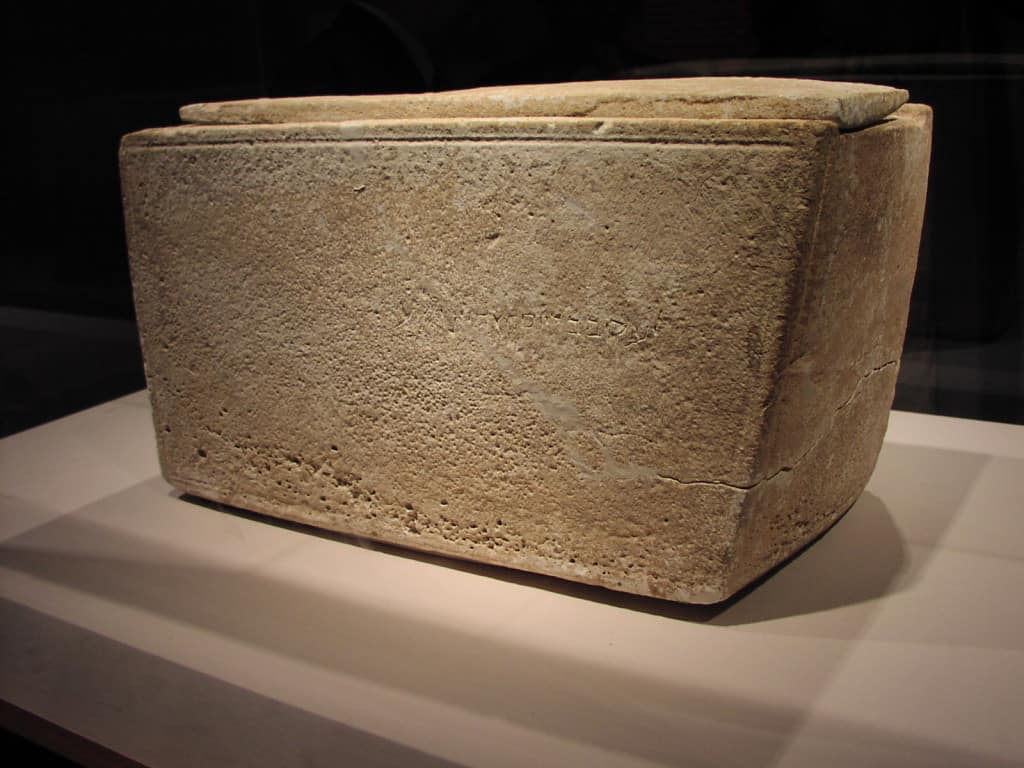
Major media throughout the world, including the New York Times and virtually every other newspaper in the world, the major wire services, and all the major TV networks, picked up the story immediately. Shanks released photographs, passed out press releases, and the full story, including Lemaire’s analysis, and that of the geologists, was published in the November/December issue of Biblical Archaeology Review. [1]André Lemaire, “Burial Box of James, the Brother of Jesus: Earliest Archaeological Evidence of Jesus Found in Jerusalem,” Biblical Archaeology Review 28:6 (2002): 24-33, 70. The SEM-EDS … Continue reading Shanks and his co-author, professor Ben Witherington also released a book, The Brother of Jesus: The Dramatic Story and Meaning of the First Archaeological Link to Jesus and His Family to coincide with the press conference.
Filmmaker Simcha Jacobovici was present throughout these dramatic events as he had contracted with Shanks to produce a TV documentary on the James ossuary that aired on the Discovery Channel, in over seventy countries, the following Easter, 2003. This much overlooked documentary is one of the best and most basic treatments of the controversial ossuary. I highly recommend it. [2]James: Brother of Jesus, Holy Relic or Hoax. It was shown over the course of the next month in over eighty additional countries.
Shanks then dropped another bombshell—the ossuary itself was being flown from Israel and would be on display at the Royal Ontario Museum in Toronto, beginning November 15, 2002—just over a month away. The city and the date had been chosen to coincide with the annual professional meetings of the Society of Biblical Literature, the American Academy of Religion, and the American Schools of Oriental Research that would be gathering the weekend before Thanksgiving in Toronto. These meetings would bring together over 10,000 of the world’s biblical scholars, professors of religion, and biblical archaeologists.
The orchestration of all of these related publications and activities could not have been more effective. The James ossuary was already being hailed as perhaps the greatest archaeological discovery of all time.
The exhibition was an overwhelming success drawing nearly 10,000 visitors to the ROM to see the ossuary. I almost crossed paths in Toronto that November with Simcha Jacobovici–whom I had never met. I was attending the annual meetings and had been invited by Shanks to join him and a group of about thirty professors for a private after-hours viewing of the exhibit. Simcha was there to document the gathering and get the first live reactions of the scholars. A who’s who of biblical scholars, experts in ancient inscriptions, and historians, filled the exhibit hall that evening. Fortunately my wife Lori was with me and took some professional photos that captured the spirit of the event and have been subsequently published in Biblical Archaeology Review magazine.
Everyone present seemed genuinely moved by the ossuary itself and impressed with its authenticity, including the renowned epigraphers Frank Moore Cross of Harvard, Joseph Fitzmyer of Catholic University of America, and Kyle McCarter of Johns Hopkins University–all of whom said in my presence that they found the inscription to be authentic from a paleographic examination. In addition to the viewing, there was a special plenary session with a panel discussion at the Society of Biblical Literature meeting that weekend. The only objection expressed on a panel that included André Lemaire, and several leading historians and archaeologists, was that giving such attention to an artifact that had been purchased on the antiquities market, and thus lacked any archaeological context that could serve to inform its interpretation, was less than ideal. One has to remember that this was the case for many of the Dead Sea Scrolls that first came to public view in 1947 because they were being offered for sale by the Bedouin who claimed to have found them in caves on the northwest shore of the Dead Sea. Sometimes the value of such archaeological finds, no matter how they end up coming to the attention of competent scholars for evaluation, outweighs these less than ideal circumstances. This is simply the reality of things in the Middle East. The archaeologists do not make some of the most important discoveries in licensed and controlled settings, but rather circumstance and luck, or even looting play their roles. Because of this lack of context one has to always be cautious, since possibility a convincing forgery is always present. [3]See the observations of Yuval Goren on-line at: https://www.bibleinterp.com/articles/Goren_Jerusalem_Syndrome.shtml.
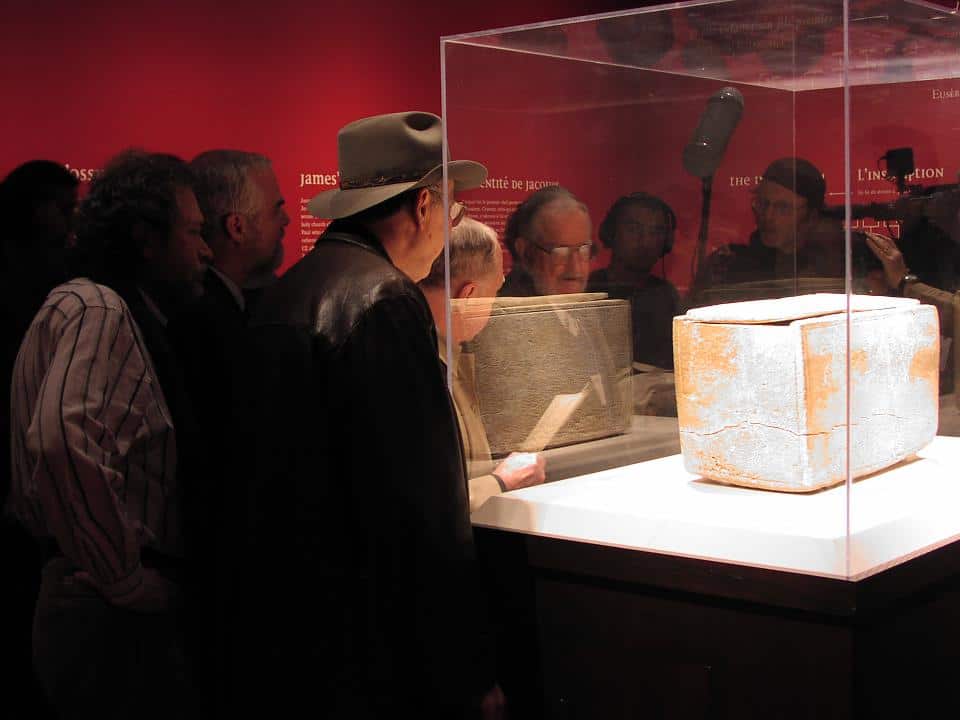
By the time of the Toronto exhibit the name of the owner of the ossuary, Oded Golan, had been leaked. The IAA launched an investigation and by the summer of 2003, just a few months after Simcha Jacobovici’s Discovery TV documentary had been released, a team of Israeli experts issued a report that concluded that although the James ossuary itself was authentic, Golan had forged all or part of the ossuary inscription in order to increase its value. Golan and four other co-conspirators, including Robert Deutsch, one of Israel’s leading antiquities dealer, were indicted on 44 charges of forgery and antiquities trafficking, not only of the James ossuary, but another inscribed artifact that had appeared on the black market in January of that year. [4]The other inscription, the Yohoash tablet, was a stone artifact with a Hebrew text that was purported to come from the reign of King Jehash in the 9th century BCE (see 1 Kings 12). See Uzi Dahari, … Continue reading
The Forgery Trial of the Century
The criminal trial (482/04 State of Israel v. Oded Golan), began in December, 2004. In the meantime charges were dropped against all but Golan and Deutsch [5]Correspondent Matthew Kalman serially reported on the entire trial for Time magazine and his articles are archived on his web site: https://jamesossuarytrial.blogspot.com/. Oded Golan has recently … Continue reading
Once the indictments were announced and the trial began in Jerusalem, a virtual bandwagon of opposition to the authenticity of the James ossuary inscription followed. This included articles in the New Yorker and Archaeology magazine, a segment on 60 Minutes and stories in most major newspapers around the world, as well as countless blog and internet posts—all concluding that Oded Golan had was part of an extended forgery ring and there was conclusive physical evidence that the James ossuary inscription was a forgery. [6]Neil Asher Silberman and Yuval Goren, “Faking Biblical History,” Archaeology 56:5 (2003): 20-29; David Samuels, “Written in Stone,” New Yorker, April 12, 2004, pp. 48-59. Since then two major books have been published, one popular, the other scholarly, purporting to document the entire scandal and weighing in on the side of forgery. [7]Nina Burleigh, Unholy Business: A True Tale of Faith, Greek, and Forgery in the Holy Land (New York: Harper-Collins, 2008) and Ryan Byrne and Bernadette McNary-Zak, eds., Resurrecting the Brother of … Continue reading The academic response on the whole has been harsh and final: “the archaeological fact [is] that the inscription is a modern forgery.” [8]Byron R. McCane, “Archaeological Context and Controversy,” in Resurrecting the Brother of Jesus, op. cit. p. 20; https://www.bibleinterp.com/articles/West_reply.shtml; … Continue reading
The general public appears to have been convinced by this tsunami of criticism, so most of the original excitement and enthusiasm for this biblical artifact has dissipated. Hershel Shanks, an experienced lawyer, and his co-author Ben Witherington, have stood their ground but reserved final judgment. Their current position is that a convincing case for forgery has not been made. A few scattered academics have agreed but by far the mainstream would chuckle at any serious mention of the James ossuary inscription as an authentic find from the time of Jesus. [9]See the comments of Craig Evans on-line at: https://www.bibleinterp.com/articles/Evans_Thoughts.shtml. Likewise, the scientists at the Geological Survey of Israel have not retracted their initial judgment as to the authenticity of the inscription and the ancient patina covering the ossuary, based on their initial physical tests.
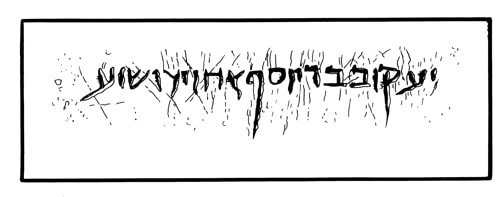
On October 3, 2010, both the prosecution and the defense concluded their cases. The trial that had lasted seven years came to an end. Judge Aharon Farkash came to a verdict on March 14, 2012. Golan was acquitted of the forgery charges but convicted of illegal trading in antiquities. The judge said this acquittal “does not mean that the inscription on the ossuary is authentic.” The ossuary has since been returned to its owner, Oded Golan, who plans to put it on public display.
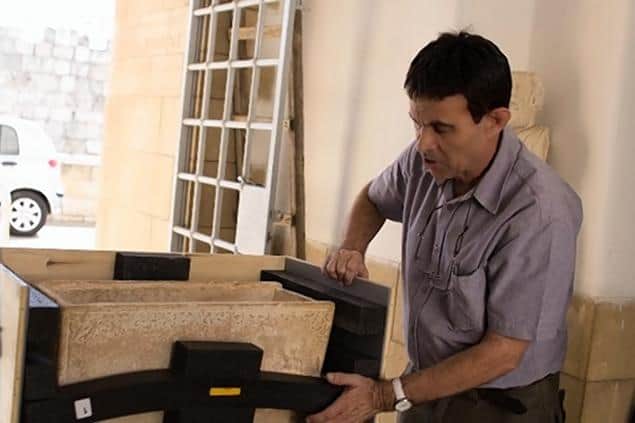
It should be noted, despite the widespread perception that the inscription was forged so far not a single epigrapher has disqualified the ossuary inscription on paleographic grounds in legal testimony—that is, the style of the writing and its integrity. See Hershel Shanks’s summary of the overall case for authenticity here. You can also download the free book, James, Brother of Jesus: The Forgery Trial of the Century, produced by the Biblical Archaeology Society.
Expert epigraphers can usually spot forgeries by examining the form and style of the letters and comparing them with inscriptions of the period in question that are known to be authentic from the archaeological contexts in which they were found. The Dead Sea Scrolls have been authenticated in this way, even though many of them also surfaced on the black market without any verifiable archaeological context. The IAA case for forgery was partly circumstantial, but primarily based on physical tests conducted by Yuval Goren. He concluded that the letters of the inscription cut through the original patina of the ossuary—the natural growth of chemical deposits that builds up over time on stone—showing that the incisions were made later—in modern times. [10]See Goren’s report at https://www.bibleinterp.com/articles/Goren_report.shtml. The indictment further charged that Golan had clumsily tried to apply a fake patina over the inscription, once he had carved it, applying a pastiche he created and mixed with hot water. The case of the prosecution suffered a tremendous blow when it was shown by experts that although the ossuary inscription had been cleaned by its owner, there was nonetheless original, authentic patina in the grooves of the letters—showing it could not have been added later. The chief witness for the prosecution on the patina authenticity, once all the testimony was out, admitted under oath that this was the case. [11]See Oded Golan’s summary of the trial testimony cited above. Based on all the trial evidence presented I think the case in favor of authenticity has become quite compelling.
Statistician Prof. Camille Fuchs had examined the prevalence of names of deceased Jewish male individuals in Jerusalem in the first century CE. He determined that it is possible to determine at a very high probability, close to 99%, that between the years 45-70 AD not more than one adult male Jew with the name James who had a father named Joseph and a brother named Jesus is likely to have lived in Jerusalem. [12]Camil Fuchs: “Demography, literacy and names distribution in ancient Jerusalem: How many James/Jacob son of Joseph, brother of Jesus were there?” in The Polish Journal of Biblical Research … Continue reading
A Missing Ossuary
Early on in our investigation Talpiot tombs, we began to consider the possibility that the unprovenanced James ossuary might have come from the Garden tomb. It was speculation at first, a hypothesis that if proven would substantiate the mounting evidence linking the Garden tomb with Jesus of Nazareth. If the mystery of the origin of the James Ossuary was somehow settled, and it did come from the Talpiot Jesus tomb, its tie to Jesus of Nazareth could hardly be questioned and of course that probability statistics based on the names found in the tomb would go through the roof. Along with the new finds in the Patio tomb, so clearly connecting these tombs to faith in Jesus’ resurrection, we would be in a position to advance our understanding of the faith of Jesus’ first followers in a most significant way.
Joseph Gath’s initial report on the Garden tomb’s excavation clearly states that there were ten ossuaries originally in the tomb. Presumably all ten were transported to the IAA lab at the Rockefeller for cataloguing and analysis. Here are Gath’s own words:
During the archaeological dig at the site 10 ossuaries were found in the different niches. No primary burial was found in the niches and only one niche was found without ossuaries (Niche no. 4). On the floor of the main room there were remains of bones, including skulls and limb bones below the burial shelves. [13]Gath published this short preliminary report in Hebrew in 1981, but before the ossuary inscriptions had been deciphered (Hadashot Arkheologiyot 76 (1981), pp. 24-26. Translation is by Noam Kusar. The … Continue reading
In 2005, when I first visited the IAA storage warehouse in Bet Shemesh outside Jerusalem to examine the Talpiot Jesus tomb ossuaries, I was accompanied by Shimon Gibson, who had been the surveyor for the excavation in April, 1980. We were both astounded when the curator informed us that everything was ready, handing us an inventory list, and offering to bring out all the ossuaries, but explaining that only nine of the ten ossuaries from this tomb were listed on his tally. He apologized, explaining that they had searched for the tenth but had no idea what had happened to it, even though it had been given a cataloguing number in 1980. His precise words were, “The tenth ossuary has gone missing.” Shimon rechecked the map he had drawn of the tomb at the time of the excavation—there was no doubt, the tomb had originally contained ten ossuaries.
Shimon and I spent hours searching through the archive files of the IAA. There were clear photos of only nine ossuaries, but nothing in the records about a tenth. We checked the 1996 published report on the tomb prepared by Amos Kloner, who was supervisor over Gath and had overseen the excavation. Kloner described each of the first nine ossuaries in detail along with the original photographs. At the end of his roster he listed the tenth, but with a one-word description and no photo:
- IAA 80.509: 60 x 26 x 30 cm. Plain
From this one line we knew that at least it had been given a catalogue number but no one seemed to have any idea what happened to it and the curator explained that it should have been photographed as part the routine registration process. He and his staff had searched and had found nothing.
Later we noticed that the Rahmani catalogue of ossuaries in the Israeli state collection also included only nine (nos. 701-709), with the comment that the tenth was plain and broken and was not retained. Its catalogue number: 80.509 is simply not included–with the list of ossuaries jumping from 80.508 to 80.510. [14]See Rahmani, Catalogue of Jewish Ossuaries, p. 222. I was finishing my book, The Jesus Dynasty, that summer I had noticed that the dimensions of the James ossuary were officially published as: 56.5 x 25 x 30.5—close but not exactly the same as the missing tenth ossuary. Simcha Jacobovici subsequently was able to re-measure the James ossuary under IAA supervision, using the standard template indicating where to take length, width, and height measurements. It was 56.5 x 25.7 x 29.5—a bit closer to the dimensions Kloner had published. Where Kloner got these dimensions we have no idea. They are not in the IAA official files on the excavation of this tomb. Apparently he has his own records of the excavation that he has not made public.
It should be noted that the James ossuary was not rectangular in shape but trapezoid, so that its dimensions, depending on which side or end measured, would vary slightly. [15]It should also be noted that Rahmani’s catalogue often gives two differing measurements for individual ossuaries, recording initial measurements as well as subsequent lab measurements that were … Continue reading For us there was enough of a “fit” that we did not think the possibility that the James ossuary was the missing tenth from the Talpiot tomb should be dismissed. Obviously, there would need to be much more evidence but I decided to mention this possibility in my book, The Jesus Dynasty, published in 2006 [16]See James D. Tabor, The Jesus Dynasty, pp. 73-83.
After the book was out I was in Jerusalem and I met with Joe Zias, a close friend who was the anthropologist at the IAA in 1980. I wanted to know what Joe thought might have happened to the tenth ossuary, based on how materials were catalogued and handled in those days. Joe said he had no specific recollection of that particular tomb or ossuary but he suggested three possibilities: 1) It was simply misplaced in storage rather than being shelved where it should be with the other nine; 2) it had been put outside in the courtyard of the Rockefeller because of lack of space and lost its tag and would now be unidentifiable; or, 3) it was discarded during one of the moves of the IAA collection since 1980—from the Rockefeller, to a warehouse in Romena, and finally to Bet Shemesh. Joe explained that things regularly go missing, with millions of artifacts from thousands of excavations, but often they show up again. Joe was quite sure the missing tenth ossuary had nothing to do with the James ossuary and told James he thought his speculation in that regard was irresponsible and misleading. That is how things stood in 2006.
See also “The Controversial James Ossuary and the Talpiot Tomb“







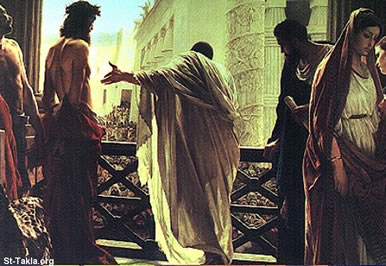
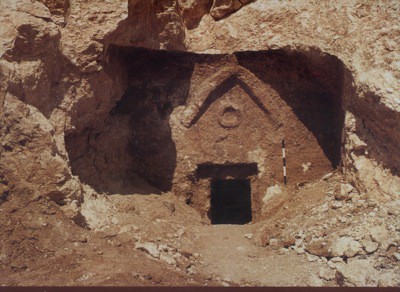
Comments are closed.